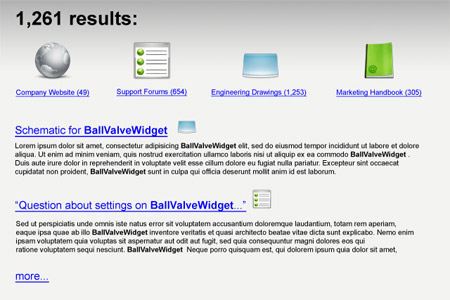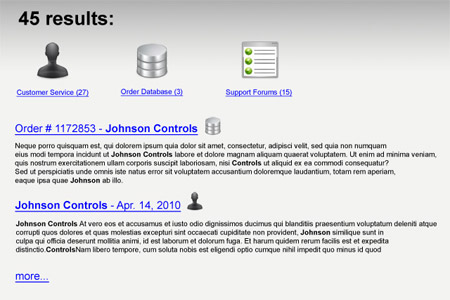Search Enterprise Data
Searching Multiple Data Sources with MaxxCAT Enterprise Search Appliances
MaxxCAT has tremendously simplified the process of searching data from multiple enterprise sources. Enterprises store their data in a wide variety of locations -- websites, intranets, database, file shares, SAN arrays, applications and decentralized PC desktops. MaxxCAT search appliances have greatly simplified the problem of aggregating, indexing and relevantly searching this data from this wide variety of sources by providing a single API to query this diverse set of data, regardless of the source.
MaxxCAT has a simple query language that has two components -- the query, and the results set. These simple building blocks work in exactly the same way across all MaxxCAT search appliances, and across all data sources. As such, developing the front end interface for a complex search application is as simple as generating a query in the standard query language, and displaying the results. The MaxxCAT search appliances handle all of the complexity of extracting the data from multiple diverse sources, securing the data, indexing the data and returning relevant results to the query.
The building block and abstract API approach allows users to manipulate a very complex and high performance appliance without having to learn a great deal about how the appliance works, or where the data is coming from. Because the standard query language is based upon open internet standards for HTML and JSON/Javascript, it is a trivial matter for even entry level developers to construct rich applications using the MaxxCAT toolset.
A separate matter, is how to load data into the appliance, and again, MaxxCAT provides a simple mechanism to attach websites, file systems, intranets, applications and databases to the appliance. Websites can be completely crawled with one line in a configuration file that gives the starting URL. Similarly, entire databases, or just certain rows of certain tables can be connected to the appliance using industry standard SQL.
For an example of how a complex enterprise search requirement can be implemented with a minimal amount of coding using industry standard tools, consider the following diagram. International Widgets is a manufacture of a diverse line of products, and has the following information sources that it desires to make available to its employees and customers.

The following are the one line MaxxCAT configuration commands to connect each of these resources to the appliance:
maxxcatdb:OrderHistory.frm [ SELECT ORDER_NUMBER, QUANTITY, DESCRIPTION, PRICE FROM HEADER,DETAIL WHERE HEADER.ORDER_NUMBER=DETAIL. ORDER_NUMBER]
URL=productliterature.widgets.com:/PDF/
URL=www.widgets.com
URL=www.acmesupply.com
maxxcatdb:FactorySchedule.frm [SELECT ORDER_STATUS, CUSTOMER_NUMBER, SHIP_DATE, PERCENT_COMPLETE, SKU, DESCRIPTION FROM FACTORY_SCHEDULE]
URL=customerservice.widgets.com/CaseStudies
URL=customerserivce.widgest.com/FAQ
URL=forums.widgets.com
URL=fileshare://engineering:
That's it! 8 disparate information systems, and only 8 lines of code to connect them all to MaxxCAT.
To query all of these data sources for a given SKU for a widget, and to break the results out into 8 different sets, corresponding to the underlying source, again, a simple line of code:
queryserver.maxxcat.com/query.cgi?query=BallValveWidget&sliceOn=DataSource

You can see how this simple query can put all of the information about a given widget at the fingertips of a user, recent orders, production schedule, problems, case studies etc.
Behind the scenes, the MaxxCAT appliance has connected to all data sources, and found every occurrence of the word "BallValveWidget", it then organizes the results into an easily navigable structure, and presents them to the user, who can continue to drill down through the appliance.
A powerful example of how a minimum amount of code and configuration can solve a very difficult problem easily using MaxxCAT technology.
Another, completely unrelated query would be to go against the enterprise sources to find out information about a given customer. Again, one line of simple intuitive code:
queryserver.maxxcat.com/query.cgi?query=Johnson+Controls&sliceOn=DataSource

Because of MaxxCAT's extreme performance, it can instantly query 8 different data sources and find out all the information about Johnson Controls known to any of the systems: Orders in production for this customer, past problems the customer has had, any time the customers name has been mentioned as part of an engineering change document and so forth.
Because MaxxCAT provides industry leading performance and the lowest price point in the industry, our appliances are becoming key components in enterprise solutions to connect the diverse data sources and applications into a single, central location that can provide a standard, simple API for developers and users to access the structured and unstructured information with very little knowledge required on the underlying mechanisms of either the MaxxCAT components, or the various host systems.
Contact MaxxCAT today for help in evaluating this technology for your enterprise.

